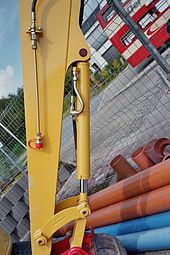Cylinder (engine)
This is the sighted version that was marked on January 24, 2021. There is 1 pending change that needs to be sighted.
![]()
This article or subsequent section is not sufficiently supported by evidence (e.g., anecdotal evidence). Information without sufficient evidence may be removed in the near future. Please help Wikipedia by researching the information and adding good supporting evidence.
No sources cited. --SteEis (Discussion | Rating | Posts) 19:33, 29 Nov 2019 (CET)
Cylinder is a term used in technology, especially in mechanical engineering, for various machine elements or assemblies. The common feature is the design at least approximately in the shape of a (circular) cylinder, often designed as a hollow cylinder.
Use of the term
General
- a rotating part of machinery used to apply pressure to a workpiece or to impart properties to the workpiece by changing its direction (e.g. in a calender or the rotary cylinder of a printing press), also known as a roller.
- the working element of a technical circuit, which is controlled by an actuator (often a valve).
For motors or pumps
- the tubular chamber in which a piston moves, as used in piston pumps, steam engines and reciprocating internal combustion engines. Such machines are called reciprocating engines. Piston engines may have one or more cylinders; in double-piston engines, cylinders with a common combustion chamber are counted as one. The stroke (linear motion) of the piston in the cylinder of the reciprocating engine may be converted into rotary motion, for example of a wheel or crankshaft, by means of a connecting rod. The inversion, i.e. the conversion of a rotation into a translation, is also possible in principle. In internal combustion engines, the cylinder opens into the crankshaft housing on one side and is closed or closable by valves on the other side.
In piston steam engines, the steam usually acts alternately on both sides of the piston, and the cylinder is closed on both sides for this purpose. The steam supply is usually controlled via slide valves, but sometimes via valves.
In counter-rotating engines, the cylinder liner is open on both sides. The working medium (gas or air, gasoline-air mixture, air for direct injection) is controlled via the intake and exhaust ports.
In linear technology
- electromechanical cylinders, also known as electromechanical lifting cylinders or electromechanical actuators. The basic principle of electromechanical lifting cylinders is also found in so-called telescopic lifting columns (also: lifting column or telescopic actuator).
Gas springs also have a cylinder which is filled with gas, the overpressure of which causes the gas cylinder piston to extend (the pre-stroke).
In fluid power
- a drive unit for linear - more rarely also rotating - movements. The movement of the piston is transmitted to the parts to be moved via the piston rod or magnetic frictional connection. The exit of the piston rod from the pressure chamber must be sealed. A distinction is made between single-acting and double-acting cylinders (work is performed in one direction only or in both directions). Cylinders in hydraulics or pneumatics are the two fluid elements
- Pneumatic cylinders and
- Hydraulic cylinder
Circuit symbols for cylinders for use in pneumatic or hydraulic circuit diagrams can be found in the list of circuit symbols (fluid power).
In printing technology
- one impression cylinder
- Cylinder printing techniques are: Cylinder against cylinder, cylinder against surface
- See also: Oscillating cylinder, cylinder press and oscillating cylinder press
Norm data (subject term): GND: 4068325-4

Cylinder liner of an opposed piston engine

A hydraulic cylinder on a construction machine
Search within the encyclopedia